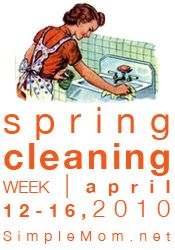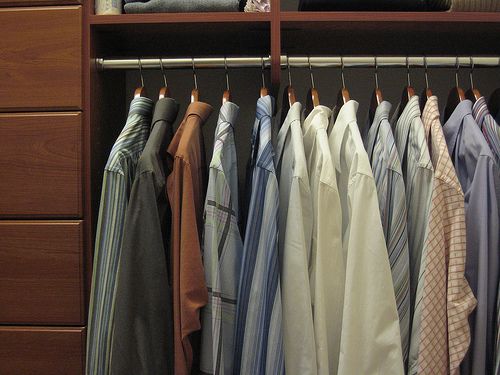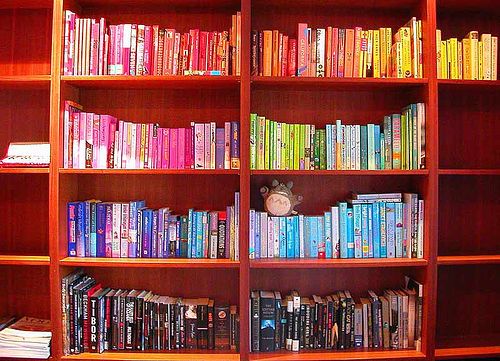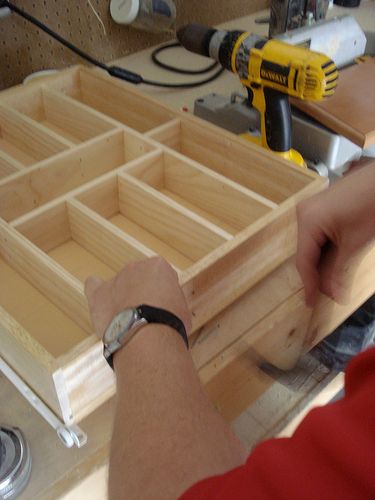This week, Tsh has been focusing on her three-step plan for spring cleaning: decluttering, cleaning, and organizing.

As you go through the process that she outlines in her ebook, Spring Cleaning for Normal People, you should be emptying each shelf, cabinet or closet, decluttering its contents, cleaning all the nooks and crannies and then organizing the items as you put them back.
For some people, decluttering is the part of the process that stops them in their tracks. Because of their emotional attachment to the stuff they’re holding onto, they’re unable to make tough decisions about letting go of those things.
For others, decluttering and organizing are the fun parts of the process, but cleaning is the one that drags them down. They want their homes to be neat and organized, but scrubbing the baseboards just doesn’t excite them.
And still others find that decluttering is easy and cleaning is no big deal, but when it’s time to organize, they’re just not sure where to start. They aren’t sure which way is the right way to organize their kitchen drawers or how Martha Stewart would say to organize their linen closet or how the toys should be organized.
Today, I want to tell you a little secret…
There is no right way to organize.
Sure, there are overarching principles that help create good organizational systems:
- Create zones for items that are used together.
- Use containers to control clutter.
- Less is more.
- Be willing to reevaluate your systems as you go.
But the right system for your home is the one that is tailored to fit your needs, lifestyle and preferences. By creating your own system, you are much more likely to be able to maintain it over time, and that is the hallmark of good organizing!
Let’s take a look at some different methods for organizing common hot spots in our homes to give you an idea of what I mean:
Closets & Wardrobes

How do you organize the clothes in your closets?
- I personally separate my short- and long-sleeved shirts and then hang them by color.
- If you work outside of the home or attend a more formal church, you may want to separate your casual and dressy clothes.
- If you hang all of your pants and skirts along with your shirts, it might make sense for you to separate them by garment.
How do you decide what to keep and what to give away?
- A popular system for decluttering your closet involves hanging all of your hangers backward at the start of the season. Each time you wear a item, you put the hanger away and then rehang it on a hanger facing the right direction after you wash it. At the end of the season, it’s easy to quickly see which clothes you wear so that you can pass the rest on.
- Meredith from Penelope Loves Lists has a different take on this system, though. She recommends that you stop doing your laundry (not including the basic unmentionables, of course) and wear a new thing every day. You’ll eventually hit a point where the things left in your closet just don’t appeal to you, and passing them on will be an easy decision.
Kitchen
What zones do you have in your kitchen?
Organizing by zone is most important in the kitchen, where organizing your tools and ingredients has a big impact on your daily meal preparations and clean up.
However, the zones in your kitchen will not be the same as mine, and they shouldn’t be. Instead, your zones should reflect the meals you prepare and the way you use your kitchen.
- That may mean setting up a coffee zone or having a zone for entertaining pieces.
- If you have little ones, it may mean having a “this cabinet is for play” zone that keeps them busy while you cook.
- Or if you have a tiny kitchen, it may mean following the lead of Shaina from Food for My Family and creating a small appliance zone in your garage.
Books

How do you organize your bookshelves?
During last year’s Spring Cleaning Party, Tsh and I both shared our systems for organizing books. I noted that our systems and philosophies are very different in this area, but that doesn’t make either one of us right or wrong.
- While Tsh keeps all of her family’s book in a reading nook in their home, where they’re organized alphabetically, we have books spread throughout our home, organized by subject or grouped by series.
- You might prefer to set up separate areas for adult and children’s books.
- Or if you’re a homeschooler, you might keep recreational reading separate from those books you use for school.
- And for those of you who are very visual, grouping the books by color might be the most appealing option for you.
Paperwork
How do you deal with the paper?
What about all of the paperwork we deal with on a daily basis – incoming mail, bills to be paid, school records and notices, business documents and more?
As with the other areas of our homes, there is no right or wrong system to deal with paperwork. The important part is that you have a system in place so that you can stay on top of the piles of paper rather than letting them build up.
- Tanna from Complete Organizing Solutions keeps her family organized with a command central, where she keeps track of any papers that need action and writes notes and reminders for herself.
- Other families may choose to create a home management notebook to serve as their second brain for contact lists, calendars, medical information and more.
- You may choose to stick with a traditional file system or scan your documents onto the computer rather than keeping physical files.
Get Creative

No matter what area of your home you’re organizing – your media library, toy room, school room, garage or outside, for example — take some time to really think through your family’s needs and come up with a system that works best for you. Think about your schedule, personalities, what’s worked in the past and what obstacles have prevented you from getting organized. Then brainstorm creative solutions to overcome them.
- For example, Marci from Overcoming Busy made adorable cereal box organizers to hold her kids’ crafts and artwork, which we all know can take on a life of their own if they’re not contained.
- Sherri from Serene Journey shared 10 ideas for using a pocket shoe organizer around your home.
- And Tanna from Complete Organizing Solutions and her husband built custom drawer organizers to help corral all the little stuff that often gets mixed up in the open space of a drawer.
While it’s great to read organizing blogs and magazines and learn from others who are more organized than you, don’t limit yourself to the systems that other people use. Try different things until you find a system that works for you.
What unconventional organizing systems do you have in your home?


